|
|
This topic comprises 2 pages: 1 2
|
|
Author
|
Topic: Old telephone plugs.
|
|
|
|
|
|
|
|
|
Stephen Furley
Film God

Posts: 3059
From: Coulsdon, Croydon, England
Registered: May 2002
|
 posted 03-02-2009 06:05 AM
posted 03-02-2009 06:05 AM




Phoneco have got them listed, on the second accessories page. I hope they've still got some in stock; I'll give them a call this evening.
It doesn't say if they accept orders from overseas.
quote: Scott Norwood
Apparently, Phil and I are not the only ones here who collect phone stuff.
Some very grotty pictures taken with my mobile 'phone, in the frame room with no proper light in it at the moment, due to building works:
GPO Engineers Telephone 280 Mk.2 1950s, still in use in the '80s
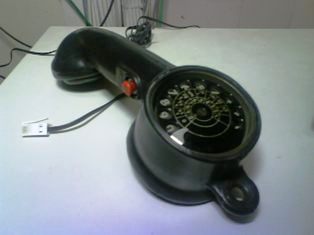
Here is the modern version, a Tempo DSTS-2, hanging on, and connected to, the frame at work:
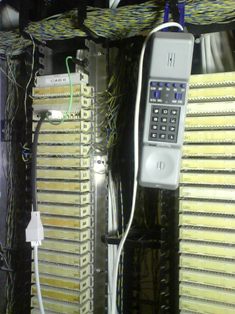
The adapter cord is from a standard British telephone plug to a special test plug to fit Krone connection strips. When you insert the plug it breaks the connection at that point, and by turning the plug over you can connect either towards the equipment, or towards the cable, which can be useful if you're injecting tone from the far end. There's a slightly different plug where the two sides are connected together, so you can insert it without breaking the connection between the user's telephone and the equipment.
The green wire clipped onto the metalwork of the frame is an earth connection to enable earth recall to be used. Most of our analogue telephones still use earth recall, but in a couple of areas where analogue circuits are patched through voice panels and Cat. 5 cables to RJ-45s in rooms there is no earth connection available, so TBR has to be used.
This is the whole frame:
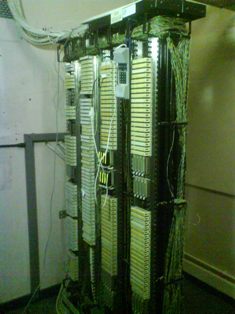
The frame is much bigger than it needs to be; the right hand side in the picture is connected to the equipment, and the left side out to the telephones around the building. Looking at the equipment side, each of the cream-coloured Krone strips can hold 10 pairs, there are 20 of them in each of the four large blocks, so that's 200 pairs in each block, or 800 in this part of the frame. There's the same again round the back on the other side of the frame, so in theory we could have 1600 pairs going to the equipment, and about the same going out to the 'phones. We don't have anything like that number, maybe half of it.
[ 03-02-2009, 07:52 AM: Message edited by: Stephen Furley ]
| IP: Logged
|
|
|
|
Stephen Furley
Film God

Posts: 3059
From: Coulsdon, Croydon, England
Registered: May 2002
|
 posted 03-02-2009 12:29 PM
posted 03-02-2009 12:29 PM




Jim,
You're on the right lines, but not quite there. It's two wires into the building to the first socket, but three, or four wires from there to the other sockets, and the 'phones use three, or four wires.
Until the early '80s the GPO (Post Office) had a monopoly on providing public telephone service, except in the city of Hull for some reason. You couldn't by a telephone to connect to the PSTN, you had to rent them from the GPO, along with your line. Most telephones were hard wired to a small junction box on the wall. Since sometime in the '40s when the 300 series was introduced it has been possible to have a telephone with the bell internal; before that it was housed in an external bell-set. These bells were low-impedance, 1k Ohm, and were wired in series when more than one telephone was installed on a line. This made thins rather complicated, as the master telephone, intermediate extensions and last extension all had to be wired differently. It was not common, but it was also possible to have extensions connected via a plug and socket, the so-called 420 plug, which was rather like a quarter inch audio jack plug, but shorter and fatter, with four sections. This made things even more complicated, as there had to be a switch contact inside each socket to short out the bell connection on that socket when the plug was removed. When the GPO had the monopoly this wasn't too much of a problem, as a GPO engineer would consult his 'N-Diagrams' which told him how to configure each 'phone, and then he wired the whole thing up.
With liberalisation, with people able to just buy telephones in shops, and plug them in this wasn't going to work. What happened was that the GPO retained the monopoly of supplying the line, and terminating it at the master socket. The owner of the building could install their own wireing from this point, but were not allowed to connect directly to the GPO wireing, they could only plug in to it. A special master socket was later introduced with a removeable front section containing punch-down terminals to which the user could attach their own extension wireing, and the front section could then be plugged into the socket contained in the rear part. If you report a fault to BT you will usually be asked to remove this front section, thereby isolating your own wireing from BTs, and plug a telephone directly into the socket behind; if this works then it's not BTs problem.
A new style of plug was introduced at this time, it has six positions, but usually only four conductors, like a RJ-11, but somewhat larger, and with the latch on the right side, like the one attached to the old test telephone in the picture I posted. I believe that this connector was chosen specifically to stop people plugging in un-approved foreign equipment. It's a nice connector, I prefer it to the RJ-11, but I think I would have accepted the latter, in the cause of standardisation.
At this point a silly decision was made, rather than put the line on the centre pair, (3&4) as on the RJ11 it's on the next pair out, (2&5). The master socket contains the bell capacitor, connected between one side of the line, pin 2 I think, and pin 3. It also contains a surge arrestor connected across the line, and an out of service resistor to enable the line to be tested when there's nothing plugged into it. Secondary sockets for extensions have none of these components, and simply have pins 2,3,4 and 5 connected in parallel with the master socket. Pin 4 is used for earth recall on some PABX systems, and pins 1 and 6 are not normally used. The bell was changed to a high-impedance (4k Ohm) one, so that all bells could be connected in parallel. This meant that all telephones could be wired the same, and any telephone could be plugged into any socket. Since the telephone has the bell connected to pin 3, a British telephone would not ring if connected via a BT to RJ-11 adapter in America, it would only ring if there was a British master socket in the circuit somewhere. You can now get adapters which have an internal capacitor to solve this problem.
With the demise of traditional bells, and telephones going all-electronic, some newer telephones simply detect the ringing signal on the line, and do not need to use pin 3 to ring.
That's about it, long story, and done for what seemed like good reasons at the time, but with hindsight I wish we'd done the same as the rest of the World.
There was a version of the plug listed with the latch on the left, which was supposed to be used for handset cords, but I've never seen one, I don't know if they were ever made. These days handset and line cords are attached to telephones via sockets, RJ-11 for the line, and the smaller 4-pin one for the handset, as elsewhere in the World. This is where the silly decision to put the line on pins 2&5 comes back to haunt us. Telephones for use in the UK either have to have the RJ-11 socket wired this way, with the line cord wired straight through, or they have to have the line on pins 3&4, as they would be elsewhere, and use a special line cord with the inner and outer pairs crossed over. Most use straight cords, but we have some, even the same make, which need crossed ones. Crossed cords are often needed on things like fax machines, and they're a pain to make, as there's not much room inside the plug to cross the wires over.
[ 03-02-2009, 05:08 PM: Message edited by: Stephen Furley ]
| IP: Logged
|
|
Mike Schindler
Phenomenal Film Handler

Posts: 1039
From: Oak Park, IL, USA
Registered: Jun 2002
|
 posted 03-02-2009 01:22 PM
posted 03-02-2009 01:22 PM




I never realized that there were phone geeks out there. My grandpa was actually the co-inventor of the modern phone jack.
As I understand it, there was another guy who worked for the phone company who was an engineering genius, but he didn't have a high school diploma, so he was only able to go so far in the company. But he pitched the idea to my grandpa, who was a higher-up, and my grandpa liked it, and took it to his supervisor.
The supervisor thought that it wasn't worth putting resources towards development on the project, but told the two of them that if they wanted to work on it after hours, he'd pay for their dinner.
So they did, and the modern phone jack is the result, and that's why Stephen's having so much trouble finding his four-prong plugs. ![[Wink]](wink.gif)
| IP: Logged
|
|
Stephen Furley
Film God

Posts: 3059
From: Coulsdon, Croydon, England
Registered: May 2002
|
 posted 03-02-2009 01:41 PM
posted 03-02-2009 01:41 PM




Rick, I'll send you a private message later this evening.
Mike, so when was the RJ-11 first introduced for telephones over there? I first saw them used for serial ports on an early 16 bit computer, sometime in the '80s. It was a considerable advance on most of the old telephone connectors in use around the World.
I really must get a digital camera; the one in my 'phone is useless, and I don't have time to develop and scan film this evening.
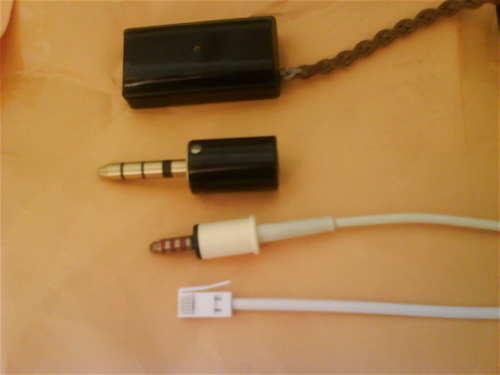
From bottom to top, a standard British telephone plug, a 420 type plug from the '60s, a 404 type, a design probably dating from the '20s or '30s, though this one was probably made in the early '50s, and a fixed connection box of similar vintage. The older plugs were not common, most telephones were hard wired at that time. The 404 is huge, and very heavy, there must be several ounces of brass in this thing. Inside the Bakelite cover there's a solid bock of brass with four slots milled in it to take the wires of the braided, cloth-covered cord, as seen above it. To give an idea of scale, the connection box is about 100 mm, four inches, long.
I've never actually seen the socket for the 404, somebody has a plug and socket pair on Ebay at the moment for 75 pounds! I think I'll give it a miss.
| IP: Logged
|
|
|
|
Stephen Furley
Film God

Posts: 3059
From: Coulsdon, Croydon, England
Registered: May 2002
|
 posted 03-02-2009 02:44 PM
posted 03-02-2009 02:44 PM




Scott,
I've just been looking at the Phoneco site; It looks very similar to Telephone Lines in Cheltenham were I got my old 280 engineers 'phone from. They have three floors packed with thousands of 'phones, just like one of the pictures on the Phoneco site. web page
The old plugs don't seem to die out; I'm told that the 420 is still used, alongside the RJ-11, in India, and the American four prong is used in Korea and Saudi-Arabia. This site lists no less than five types for Germany.
I mentioned the 'N-Diagrams'. These were something of a work of art, all the text on them was very neatly hand-written, and the pictures were hand-drawn. Many of them are available here:
For example, suppose you were a GPO engineer going to install a 706 telephone, something quite similar to the American 500, in the '60s or '70s. N806 would tell you how to to connect up he telephone internally for various different configurations, if you needed to install extra parts, mainly switches, in it then N808 would tell you about those, and 809 about the buttons to operate them. For the slightly later N746 'phone you'd need N846, N848 and N849. The various ways that telephones could be installed were known as 'plans'. One common way of connecting fixed extensions was Plan 1A, covered by N4502, and if you also wanted portable plug-in extensions that was covered by Plan 4, N4520. These N-diagrams covered all equipment, right back to the early wall-mounted wooden telephones. They really are very useful for collectors trying to get old equipment working again. I received some parts in the post today, and I'm just about to convert a 746 telephone into a Plan 4 portable extension with a couple of extra switches and a special line cord.
[ 03-02-2009, 04:17 PM: Message edited by: Stephen Furley ]
| IP: Logged
|
|
|
|
|
|
|
|
Stephen Furley
Film God

Posts: 3059
From: Coulsdon, Croydon, England
Registered: May 2002
|
 posted 03-03-2009 07:49 PM
posted 03-03-2009 07:49 PM




Scott,
This page gives it the other way round, red for tip and green for ring for line 1. Has he got it the wrong way round? Here tip is red and ring is white for cords, with blue for bell and green for earth, though old phones used blue for earth. If I just take the tip and ring wires and connect these to the jack, and ignore the bell wire, then it should work.
British ringing current is 75V a.c. 25Hz, 0.4s on, 0.2s off, 0.4s on 2s off, I think I've got those times right, it's something similar to that anyway, to give the characteristic Brr-Brr Brr-Brr double ring that we have here, so the 'phones won't sound right when they ring,but it should work.
There's also a difference in dial pulse trains as well, ours are 67% break, 33% make but I think yours are 60% and 40%, but I'm sure it will be close enough; if you can dial by just tapping the hook switch then it can't be that critical.
Which pins on the four prong plug are used for tip and ring? How should the jacks be mounted; so the cord comes out of the plug downwards?
There's something else odd over here; the official standard for the plugs numbers the wires from left to right, whereas BT number the jacks the other way, starting from the latch side. You seem to have an over-complicated electrical system, and we have an over-complicated telephone one.
I think it was you that mentioned the telephone with the illuminated dial. We can go one better than that, we had a 'phone with an illuminated dial which didn't need a transformer, or extra wires; it was radioactive! It actually contained a tube of radioactive gas behind the dial. This wasn't to much of a problem for a user with one or two 'phones, but when BT came to scrap several thousand of the things they found themselves with a considerable quantity of radioactive waste on their hands.
This was the Trimphone, There are pictures of them on
this page
On the same page the 706 and 746 are pretty much like your 500, and if you look at the page with the older models, the 300 series was similar to your 302, though made of Bakelite, rather than metal or thermoplastic. The 200 series was pretty much equal to the WE 202, though a different shape. On the Phoneco site the AE 80, I think that was the number, is also rather similar to our 706. Other than special ones for things like hazardous areas and outdoor use, we haven't generally had metal telephones here since the Candlesticks, in the '20s. The Bakelite ones are very heavy though.
| IP: Logged
|
|
|
|
All times are Central (GMT -6:00)
|
This topic comprises 2 pages: 1 2
|
Powered by Infopop Corporation
UBB.classicTM
6.3.1.2
The Film-Tech Forums are designed for various members related to the cinema industry to express their opinions, viewpoints and testimonials on various products, services and events based upon speculation, personal knowledge and factual information through use, therefore all views represented here allow no liability upon the publishers of this web site and the owners of said views assume no liability for any ill will resulting from these postings. The posts made here are for educational as well as entertainment purposes and as such anyone viewing this portion of the website must accept these views as statements of the author of that opinion
and agrees to release the authors from any and all liability.
|

 Home
Home
 Products
Products
 Store
Store
 Forum
Forum
 Warehouse
Warehouse
 Contact Us
Contact Us




 Printer-friendly view of this topic
Printer-friendly view of this topic







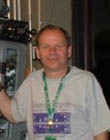


![[Wink]](wink.gif)




